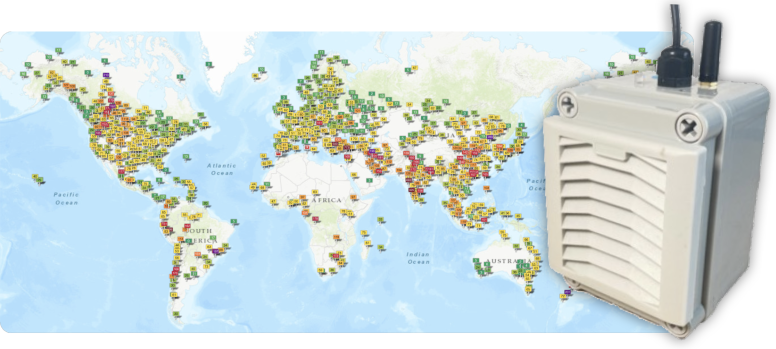
انتشار دادهها در پروژه شاخص کیفیت هوای جهانی برای همه رایگان است. اما همچنین ساده و سرراست است: تنها چیزی که برای افزودن دادهها به نقشه شاخص کیفیت هوای جهانی نیاز دارید، ارائه یک URL خوراک با اطلاعات لحظهای درباره ایستگاههای نظارت (نام و مکان)، آلایندههای اندازهگیری شده و واقعی است. - قرائت زمان (همراه با واحدها، به عنوان مثال میلی گرم یا ppb).
معیارهای صلاحیت
توجه داشته باشید که از نظر تاریخی، دادههای منتشر شده در نقشههای شاخص کیفیت هوای جهانی (aqicn.org و waqi.info) تنها دادههای رسمی ارائهشده توسط آژانس حفاظت از محیطزیست هر کشور مربوطه بود (به فهرست کامل EPA مراجعه کنید).
دادههای رسمی به دادههای پایش شده با استفاده از ایستگاههای نظارت بر کیفیت هوای حرفهای BAM، TEOM و مشابه با هزینه بالا اشاره دارد. استفاده از این ایستگاهها بیاهمیت نیستند و نیاز به نگهداری و کالیبراسیون مداوم توسط تیمهای مهندسی میدانی حرفهای EPA دارند.
با این حال، امروزه، ایستگاههای پایش کیفیت هوا مبتنی بر پراکندگی لیزری مقرونبهصرفهتر بهعنوان همراهی با ایستگاههای رسمی پایش کیفیت هوا استفاده میشوند. ایستگاه های مقرون به صرفه تر می توانند 1000 برابر کمتر از ایستگاه های BAM و TOEM هزینه داشته باشند.
ما توصیه می کنیم برای این منظور از ایستگاه های نظارت بر کیفیت هوای نیمه حرفه ای GAIA استفاده کنید. اما ما داده های ایستگاه های دیگر را نیز می پذیریم. با این وجود، چنین ایستگاه های مبتنی بر ضد ذرات نیاز به گزارش تغذیه داده های پیشرفته با کنترل های کیفیت اضافی دارند (به بخش کنترل کیفیت مراجعه کنید).
قالب فید
از آنجایی که تقریباً هر کشوری قالب گزارش خود را دارد، پروژه شاخص کیفیت هوای جهانی میتواند هر نوع قالبی را برای فیدها بپذیرد: آنها میتوانند در CSV، JSON یا فقط متن ساده یا فرمت HTML باشند. می توانید در پایین این صفحه 3 مثال برای CSV، HTML و JSON پیدا کنید.
برای مرجع، فیدهای رسمی سنگاپور یا هلند را بررسی کنید و متوجه شوید که علیرغم اینکه همه آنها متفاوت هستند، می توانند توسط سیستم ما جذب شوند.
برای شمارشگرهای ذرات هوای فوری، می توانید داده ها را از طریق وب سرور خودمان یا از طریق thingspeak گزارش دهید.
بلع داده ها
سیستم شاخص کیفیت هوای جهانی مراقب بررسی منظم دادهها از فید خواهد بود و هر بار که یک بهروزرسانی در دسترس باشد، پردازش میشود، به مقادیر AQI مقیاس EPA ایالات متحده تبدیل میشود و در وبسایت شاخص کیفیت هوای جهانی منتشر میشود. دقایق.
همچنین، اگرچه تنها داده های مربوط به کیفیت هوا PM 2.5 ، PM 10 ، ازن، NO 2 ، SO 2 و CO منتشر شده است، این سیستم آلاینده های بیشتری را برای اهداف پیش بینی جمع آوری می کند: بنزن، تولوئن، اتیل بنزن، NOx ، THC، NMHC، PM 1 . فرمالدئید، جیوه، آمونیاک، متان، سولفید هیدروژن، اسید نیتروژن، فنل، نفتالین، پاراکسیلن (p-Xylen)، متاکسیلن (m-Xylen) و غیره.
همچنین امکان انتشار داده های هواشناسی وجود دارد: دما، فشار اتمسفر، رطوبت، بارش، سرعت باد، جهت باد، تابش خورشیدی و UVI. در صورت عدم ارائه، از سایر منابع اطلاعاتی مربوط به هواشناسی استفاده خواهیم کرد.

